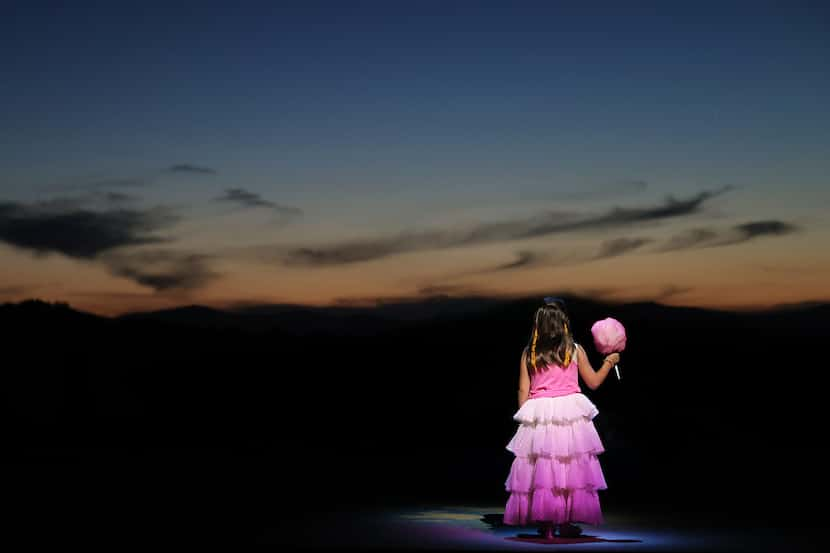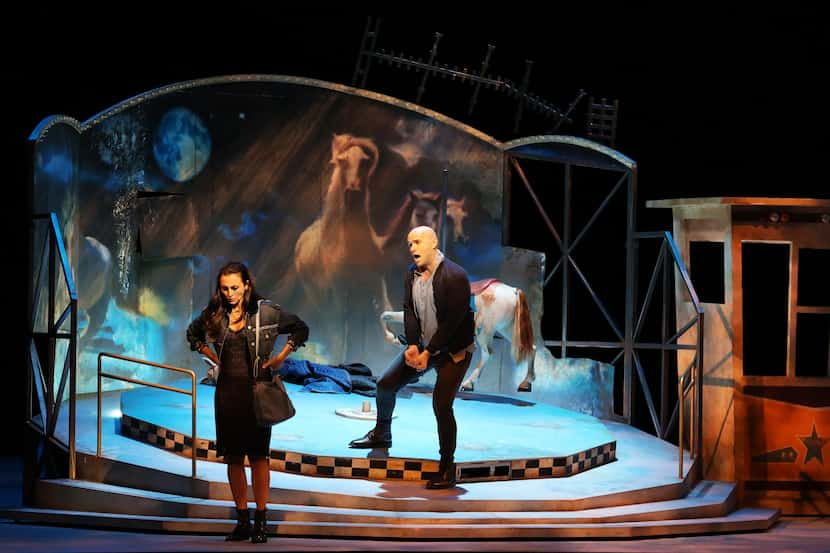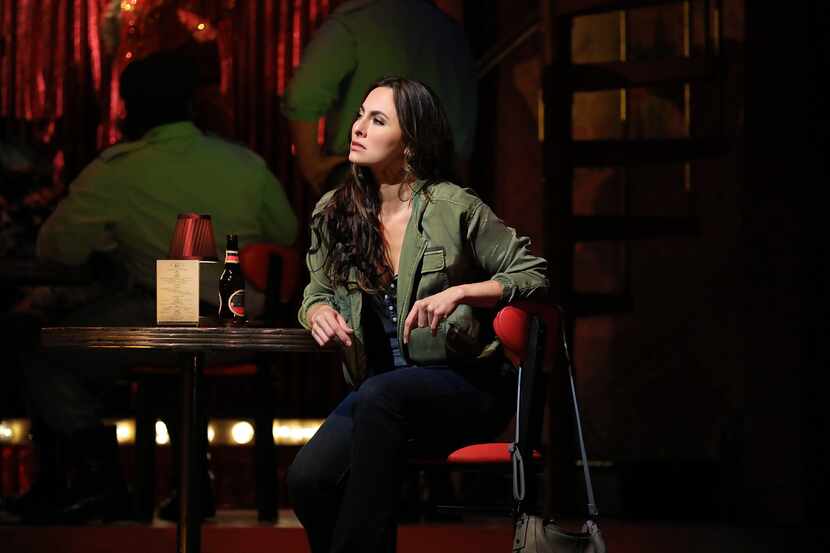SANTA FE, N.M. — The Spanish city of Seville is the setting for several operas, including Rossini’s Barber of Seville and Bizet’s Carmen. Both, as it happens, are being presented this summer by Santa Fe Opera, in productions mixing traditional and modern visuals — sometimes provocatively, sometimes questionably.
The Barber, staged by Stephen Barlow, lays it on heavy with the gags, which sometimes distracted from important moments in the Aug. 1 performance. In Figaro’s most famous aria, about his skills as a jack-of-all-trades and quick-witted operator, he passed the repetitions of his name among several boisterous barbers.
Sets and costumes by Andrew D. Edwards, with Rebecca Gunstone as associate, added to the shtick. Near the end of the overture, a giant neoclassical bust was moved forward to line up with a big pair of hedges shaped like a mustache, eliciting laughter that drowned out the fleet playing from the orchestra, led by the young conductor Iván López-Reynoso.
Count Almaviva’s servant, Fiorello, voiced by the finely focused baritone Kyle Miller, then walked onstage, wearing an 18th-century outfit, but carrying a Gap shopping bag. The count (tenor Jack Swanson) appeared as the poor student “Lindoro,” dressed in jeans, white sneakers, Seville sweatshirt and overcoat. With the help of street musicians, he serenaded his love, Rosina, ensconced in the giant bust, which served as her guardian Doctor Bartolo’s home, revolving on a turntable to reveal a couple of rooms.
Mixing the past and present created funny contrasts — as when Bartolo puts a headband and armbands over his ruffly period costume, lays out a yoga mat and strikes some poses to de-stress. But it also raised some unresolved questions. When is this actually set? Are the singers in the modern day, but acting as historical figures? And why are they sometimes aware of modernity, other times not?

Other decisions came off well, regardless of time period. Rosina’s room in Bartolo’s house resembled a large bird cage, in which she swung back and forth on a cushioned swing when singing about how she may appear docile, but will fight for what she wants.
Joshua Hopkins as Figaro wielded a powerful and generously expressive baritone. Bringing the character to life, he strutted around, took furtive sips from a flask and appeared obsessed with money. You could see a twinkle in his eye when imagining riches awaiting him for helping unite Rosina and the count.
After an excellent showing in the world premiere of Huang Ruo’s M. Butterfly, bass Kevin Burdette again performed superbly, giving Bartolo unusual depth and range. Conspiring mischievously, the music teacher, Don Basilio, was sonorously portrayed by bass-baritone Nicholas Newton.
Swanson’s Almaviva had a light voice that wasn’t always firm in pitch in runs. But he did unleash some ringing high notes. As Rosina, mezzo Emily Fons sounded vocally undernourished and was swamped in ensemble passages.
As the count’s housekeeper, Berta, soprano Murrella Parton looked fed up with the antics, swearing against love, before revealing romantic desire in a show-stopping aria involving a quick change from a drab maid’s outfit to a sparkling formal gown.
López-Reynoso, the conductor, set relaxed yet buoyant tempos that allowed room for rhythmic liberties. He drew out both lyrical and lively sounds, but sometimes let the orchestra overpower the singers. Intonation and coordination problems, particularly in the strings, started coming up as the night went on.
Prepared by Susanne Sheston, the chorus offered stirring singing but too much slapstick. Christopher Akerlind’s lights tracked changes in atmosphere. The most majestic lighting of the evening came from the sun setting over the distant mountains, casting soft purples and reds.
Santa Fe Opera’s modern ‘Carmen’
This conceptual Carmen, staged by Mariame Clément, is performed as Bizet composed it, with spoken rather than the sung dialogue subsequently composed by Ernest Guiraud.
It opens with a girl in a pink shirt and frilly white skirt — Isla Burdette, daughter of bass Kevin Burdette — in a run-down amusement park. When the orchestra struck the first accent of the prelude in the Aug. 2 performance, she crouched down and covered her ears, later skipping around a merry-go-round with a decapitated horse. She returned throughout the opera, occasionally interacting with the other characters.

Who was she? Carmen’s younger self? A ghostly presence? In any case, she provided some poignancy. She walked purposefully onstage in the final scene and stared at Don José, condemning him for killing Carmen.
Isabel Leonard was an assured and strong-willed Carmen. Wearing modest modern clothing, she captivated the men with a full-bodied mezzo, smoldering down low, blazing up high. In her arias, she stretched the tempo like putty, challenging the orchestra to stay with her. It mostly succeeded, with the exception of trouble spots in the “Habanera.”
Her ardent lover, Don José, was animated by tenor Michael Fabiano. His formidable instrument colored exquisite piano dynamics, but generally ranged between forte and triple forte, passionately conveying both his devotion and hysteria.

As Micaëla, Don José's innocent fiancée, soprano Sylvia D’Eramo didn’t project as well as the other leads, but she sculpted lovely phrases, skillfully changing dynamics and tone colors. The bullfighter Escamillo was portrayed by Michael Sumuel with a beefy mix of a bass-baritone that he lightened as needed. Zuniga, a lieutenant, was ably dispatched by bass David Crawford. Supporting roles were capably served by Magdalena Kuźma (Frasquita), Kathleen Felty (Mercédès), Luke Sutliff (Dancaïre) and Anthony León (Remendado).
Harry Bicket, Santa Fe Opera’s music director, led the orchestra in a spirited and alert collaboration, featuring sumptuous lyricism. Duane Schuler’s lights conjured various shades of darkness, bringing out the tragic mood. Choruses representing smugglers, factory workers and soldiers in hideous mint-green uniforms were equally adept in rousing and reflective passages. The children’s chorus was omitted.
Details
The Santa Fe Opera festival runs through Aug. 27. For information and tickets, call 1-800-280-4654 or visit santafeopera.org.
UPDATED at 11:35 a.m. Aug. 5 to correct a reference to specific mountains visible from the festival.


/cloudfront-us-east-1.images.arcpublishing.com/dmn/FGMATCSGLKPS7ZC4U7A4QS4IHM.jpg)
:no_upscale()/cloudfront-us-east-1.images.arcpublishing.com/dmn/VV3O77J4DBH5RPTY2DSA3U4GGU.jpg)
/cloudfront-us-east-1.images.arcpublishing.com/dmn/VVGIMAHWGFF2BPST7A36S4AYJY.jpg)
/cloudfront-us-east-1.images.arcpublishing.com/dmn/ZUEUJ7N2TVA4RJVGN4DUDJ4OFE.jpg)
/cloudfront-us-east-1.images.arcpublishing.com/dmn/UAFB7JKGDZFHZEJ42CJRJY452I.jpg)